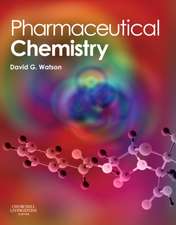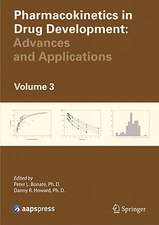Pharmacokinetic-Pharmacodynamic Modeling and Simulation
Autor Peter L. Bonateen Limba Engleză Paperback – oct 2014
| Toate formatele și edițiile | Preț | Express |
|---|---|---|
| Paperback (1) | 1329.37 lei 6-8 săpt. | |
| Springer Us – oct 2014 | 1329.37 lei 6-8 săpt. | |
| Hardback (1) | 1676.85 lei 38-44 zile | |
| Springer Us – iul 2011 | 1676.85 lei 38-44 zile |
Preț: 1329.37 lei
Preț vechi: 1399.35 lei
-5% Nou
Puncte Express: 1994
Preț estimativ în valută:
254.38€ • 262.43$ • 212.28£
254.38€ • 262.43$ • 212.28£
Carte tipărită la comandă
Livrare economică 26 martie-09 aprilie
Preluare comenzi: 021 569.72.76
Specificații
ISBN-13: 9781489973863
ISBN-10: 1489973869
Pagini: 640
Ilustrații: XIX, 618 p. 301 illus., 4 illus. in color.
Dimensiuni: 210 x 279 x 34 mm
Greutate: 1.56 kg
Ediția:2nd ed. 2011
Editura: Springer Us
Colecția Springer
Locul publicării:New York, NY, United States
ISBN-10: 1489973869
Pagini: 640
Ilustrații: XIX, 618 p. 301 illus., 4 illus. in color.
Dimensiuni: 210 x 279 x 34 mm
Greutate: 1.56 kg
Ediția:2nd ed. 2011
Editura: Springer Us
Colecția Springer
Locul publicării:New York, NY, United States
Public țintă
GraduateDescriere
This is a second edition to the original published by Springer in 2006. The comprehensive volume takes a textbook approach systematically developing the field by starting from linear models and then moving up to generalized linear and non-linear mixed effects models.
Since the first edition was published the field has grown considerably in terms of maturity and technicality. The second edition of the book therefore considerably expands with the addition of three new chapters relating to Bayesian models, Generalized linear and nonlinear mixed effects models, and Principles of simulation. In addition, many of the other chapters have been expanded and updated.
Since the first edition was published the field has grown considerably in terms of maturity and technicality. The second edition of the book therefore considerably expands with the addition of three new chapters relating to Bayesian models, Generalized linear and nonlinear mixed effects models, and Principles of simulation. In addition, many of the other chapters have been expanded and updated.
Cuprins
The Art of Modeling.- Linear Models and Regression.- Nonlinear Models and Regression.- Variance Models, Weighting, and Transformations.- Case Studies in Linear and Nonlinear Modeling.- Linear Mixed Effects Models.- Nonlinear Mixed Effects Models: Theory.- Nonlinear Mixed Effects Models: Practical Issues.- Nonlinear Mixed Effects Models: Case Studies.- Bayesian Modeling.- Generalized Linear Models and Its Extensions.- Principles of Simulation.- Appendix.- Index
Notă biografică
Peter Bonate has 16 years industrial experience, 13 years as a clinical pharmacologist/pharmacokineticist and three years in drug metabolism and bioanalysis. He is currently a Director in the Clinical Pharmacology, Modeling, and Simulation department at GlaxoSmithKline in the oncology and rare diseases therapeutic areas. He has worked at Genzyme, Hoechst Marion Roussel, Eli Lilly, and Quintiles. He received his PhD in 1996 from Indiana University in Medical Neurobiology with an emphasis on the pharmacokinetics of drugs of abuse. He received an MS in statistics from the University of Idaho and an MS in Pharmacology from Washington State University, both in 1990. In 2003 he was elected a Fellow of the American College of Clinical Pharmacology and in 2007 was elected a fellow of the American Association of Pharmaceutical Scientists (AAPS). He was founder of the Modeling and Simulation focus group, has served as chair of the population pharmacokinetics focus group, and was the Clinical Pharmacology and Translational Research Section Chair within AAPS. He has served or currently serves on the editorial boards for the Journal of Clinical Pharmacology, Pharmaceutical Research, Journal of Pharmacokinetics and Pharmacodynamics, and The AAPS Journal. He has more than 50 publications in the field of pharmacokinetics and clinical pharmacology, is co-editor of the 3-volume series Pharmacokinetics in Drug Development published by AAPS Press in 2004 and 2011, and is author of the book Pharmacokinetic-Pharmacodynamic Modeling and Simulation published by Springer in 2006. In 2010, he became an Adjunct Assistant Professor at the Indiana University School of Medicine and the University of North Carolina, Chapel Hill.
Textul de pe ultima copertă
Since its publication in 2006, Pharmacokinetic-Pharmacodynamic Modeling and Simulation has become the leading text on modeling of pharmacokinetic and pharmacodynamic data using nonlinear mixed effects models and has been applauded by students and teachers for its readability and exposition of complex statistical topics. Using a building block approach, the text starts with linear regression, nonlinear regression, and variance models at the individual level and then moves to population-level models with linear and nonlinear mixed effects models. Particular emphasis is made highlighting relationships between the model types and how the models build upon one another.
With the second edition, new chapters on generalized nonlinear mixed effects models and Bayesian models are presented, along with an extensive chapter on simulation. In addition, many chapters have been updated to reflect recent developments. The theory behind the methods is illustrated using real data from the literature and from the author's experiences in drug development. Data are analyzed using a variety of software, including NONMEM, SAS, SAAM II, and WinBUGS. A key component of the book is to show how models are developed using an acceptance-rejection paradigm with the ultimate goal of using models to explain data, summarize complex experiments, and use simulation to answer "what-if" questions. Scientists and statisticians outside the pharmaceutical sciences will find the book invaluable as a reference for applied modeling and simulation.
With the second edition, new chapters on generalized nonlinear mixed effects models and Bayesian models are presented, along with an extensive chapter on simulation. In addition, many chapters have been updated to reflect recent developments. The theory behind the methods is illustrated using real data from the literature and from the author's experiences in drug development. Data are analyzed using a variety of software, including NONMEM, SAS, SAAM II, and WinBUGS. A key component of the book is to show how models are developed using an acceptance-rejection paradigm with the ultimate goal of using models to explain data, summarize complex experiments, and use simulation to answer "what-if" questions. Scientists and statisticians outside the pharmaceutical sciences will find the book invaluable as a reference for applied modeling and simulation.
Caracteristici
Expanded and updated second edition
Comprehensive volume with a textbook approach
Three new chapters relating to Bayesian models, Generalized linear and nonlinear mixed effects models, and Principles of simulation
Includes supplementary material: sn.pub/extras
Comprehensive volume with a textbook approach
Three new chapters relating to Bayesian models, Generalized linear and nonlinear mixed effects models, and Principles of simulation
Includes supplementary material: sn.pub/extras







